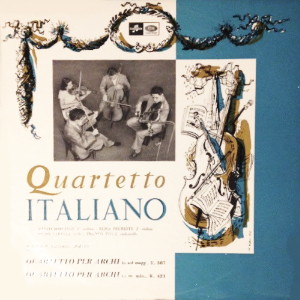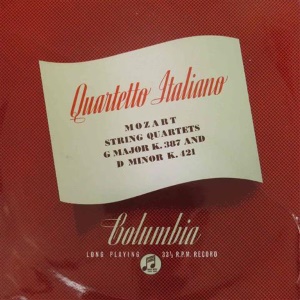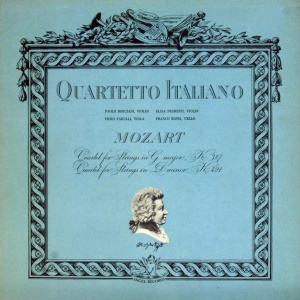 |
|
1 LP -
33QCX 10025 - (p) 1953
|
 |
| 1 LP -
33CX 1102 - (p) 12/1953 |
 |
| 1 LP -
35063 - (p) 19xx |
|
| Wolfgang
Amadeus MOZART (1756-1791) |
|
|
|
| Quartetto n. 14
in sol maggiore, K. 387 |
|
--' --" |
|
| -
Allegro vivace assai |
--' --" |
|
|
| -
Minuetto e Trio |
--' --" |
|
|
| -
Andante cantabile |
--' --" |
|
|
| -
Molto allegro |
--' --" |
|
|
|
|
|
|
| Quartetto
n. 15 in re minore, K. 421 |
|
--' --" |
|
| - Allegro |
--' --" |
|
|
| -
Andante |
--' --" |
|
|
| - Minuetto e Trio |
--' --" |
|
|
- Allegretto ma
non troppo - Pił allegro
|
--' --" |
|
|
|
|
|
|
| QUARTETTO
ITALIANO |
|
| - Paolo
Borciani, violino I |
|
| - Elisa Pegreffi,
violino II |
|
| - Piero Farulli,
viola |
|
| - Franco Rossi,
violoncello |
|
|
|
|
|
Luogo
e data di registrazione |
|
Basilica
Sant'Eufemia, Milano (Italia) -
6-8 ottobre 1953 |
|
|
Registrazione: live /
studio |
|
studio |
|
|
Producer / Engineer |
|
- |
|
|
Prima Edizione LP |
|
Columbia
(Italia) - 33QCX 10025 - (1 LP) -
durata --' --" - (p) 1953 - Mono
Columbia (United Kingdom) - 33CX
1102 - durata --' --" - (p) 1953 -
Mono
Angel Records (USA) - 35063 -
durata --' --" - (p) 19xx - Mono
|
|
|
Note |
|
- |
|
|
|
|
|
Unlike Beethoven,
Mozart was a facile composer,
but the six quartets (Op. X,
1783-1785) he dedicated to
Haydn were "the fruit of long
and arduous toil": thus he
describes them in his dedication.
"During your last stay in
this capital, Vienna, "he
continues, "you yourself my
dear friend, expressed to me
your approval of these
compositions. Your good
opinion... leads me to hope that you
will not consider them
wholly unworthy of your
favour." (The dedication
is in Italian: I have
partly availed myself of
Emily Anderson's
translation.) Two powerful
motives joined forces in
Mozart's mind in order to
create these conscientious and
conscious masterpieces.
One was the thought of
the dedicatee, to whom
they owed much (and who,
in his turn, came to owe
much to them). The other
was Mozart's realization
of the fact that the
string quartet is a
supreme challenge as
well as a supreme
responsability:
superficially the least
"effective" of all
musical media, it can
be, spiritually, the
most telling. Sure
enpugh, without the sage
yet fullblooded serenity
of K. 387 (the first of
the "Haydn" set), and
without the deep yet
optimistic tragedy of
K. 421 (the second),
two central events in
the story of the human
mind would have
remained untold.
QUARTET
IN G MAJOR, K.
387
The first
movement's
forthright first
subject shows a
duality of forte
and piano
which Mozart had
developed
into a highly
characteristic
means of
structural
expression, even
though he
probably "had
it" from Johann
Christian Bach.
In the latter
part of the
theme, the dual
approach expresses
itself in a
different way,
i.e. texturally
rather than
dynamically: the
phrases are
distributed
between the
instruments. The
little chromatic
semiquaver
figure in the
second subject
does not really
consist of two
notes that have
the same rights
and privileges;
the upper note
is merely
"coloured" by
the lower one in
order to keep up
the movement
(thus remindings
us of the origin
of the term
"chromatic": khroma
means colour).
The principle of
thematic
distribution
between the
instruments is
maintained both
in this theme
and in the
development,
which the three
upper
instruments
introduce with
three
consecutive, and
as it were
cumulative,
variations on
the first
subject.
In
the minuet,
the
afore-mentioned
dynamic
dualism is
compressed
within the
narrowest
possible
space:
successive
notes
alternate
between forte
and piano,
as indeed they
had already
done at the
end of the
opening
movement's
second
subject. The
displacement
of accent thus
achieved
results, in
effect, in a
temporary 2/4
time, all the
more so since
the opening
bars' first
beats ean
easily be
heard as
upbeats.
The
slow movement
is in abridged
sonata form,
which is to
say that a few
modulating
bars take the
place of the
development.
(A "quick"
example of
this forms is
the Figaro
Overture.)
In
structure and
texture alike,
the finale is
the most
original
movement:
alternations
between the
"learned" and
the "galant"
styles between
fugue and
accompanied
melody, are
built into
what thus
becomes an
unprecedented
sonata arch,
which iteself
forms a
precedent for
the last
movement of
the "Jupiter"
Symphony
(1788); the
two finales
share,
moreover,
their art of
developing an
in iteself
meaningless
tag (the theme
of the first
subject) into
an
overshelmingly
meaningful
form of the
sybtlest
complexity.
The
recapitulation
emits the
opening a
device
foreshadowed
as early as
the famous D
major Violin
Concerto, K.
218, of 1775.
QUARTET
IN D MINOR, K.
421
The
first
subject's
weighty bass
sets the pace
as well as the
mood of the
first
movement.
Significantly
enough, the
key of this
mood, D minor,
is that of
Mozart's first
Piano Concerto
in the minor
mode the
celebrated K.
466 of 1785.
The second
subject, in
the relative
major, views
the tragedy of
the first in
perspective.
It consistes
of a theme and
one variation
whose triplets
offer the
first fiddler
a legitimate
opportunity
for a touch of
brillance. Not
that the
triplets are
limited in
their formal
function: they
help to build
the closing
section of the
exposition,
whence they
radiate into
the
development.
The
recapitulation's
variations on
the second
subject
succeed in
uniting the
(tonic) minor
mood with a
major
emotional
liberation.
The "cello
receives the
lion's share
of the coda
and justifies
the metaphor
in the
process.
Although
the slow F
major movement
is in ternary
(A-B-A)
form, the
contrasting
middle section
is strctly
thematic; its
central
portion is, in
fact,
an A flat
major
variation on
the movement's
theme.
As
opposed to its
playful trio,
the minuet is
extremely
serious: metre
and lay-out
apart, it has
severed itself
from the dance
form. The
threads of the
chromatically
descending
bass are taken
up by the
fiddles in the
middle
section.
The
finale
consists of
four
variations and
a quicker coda
on a
siciliana-like
tune which
derives from
Haydn's String
Quartet, Op.
33, No. 5.
Rhythmically,
the most
complex
variation
- and
one of the
most
complicated
structures in
the whole of
Mozart - is in
the second.
It is what one
would nowadays
call
"polyrhythmic",
the viola
being the only
instrument
which plays
throughout the
rhythm of the
time signature
(6/8). To all
intents and
purposes, the
first violin
plays in
triple time,
while the
second, which
has the really
knotty part in
that it has to
be both
flexible and
decisive,
pursues an
unperturbed
quadruple
metre. The 'cello,
finally, may
be said to
prefer a
semple duple
time. The
third
variation
contains one
of whose viola
solos (in a
dialogue with
the two
fiddles which
play in octave
unison) which
remind one, by
way of
retrospective
illusion, of
Mozart's own
viola playing:
while he was
not
particularly
enamoured of
the violin, he
loved to play
the viola; and
to complete
our aural
illusion with
historical
accuracy,
Haydn and
Dittersdorf
would be
playing the
violin unison!
The fourth
variation is
in the major,
but the
recapitulatory
coda returns
to the minor,
until at the
very end the
major gains
the upper hand
not without a
warning B flat
in the final
cadence.
Note by
Hans Keller
(Columbia
33CX 1102)
|
|

